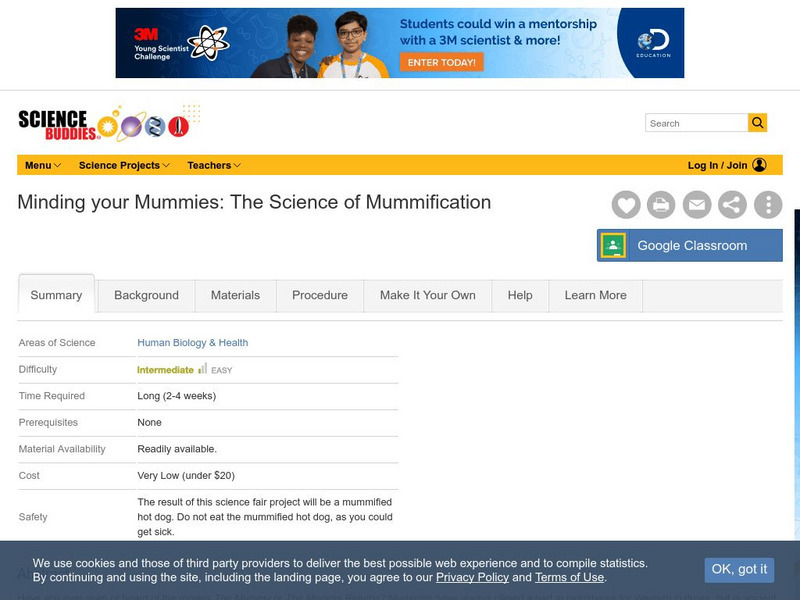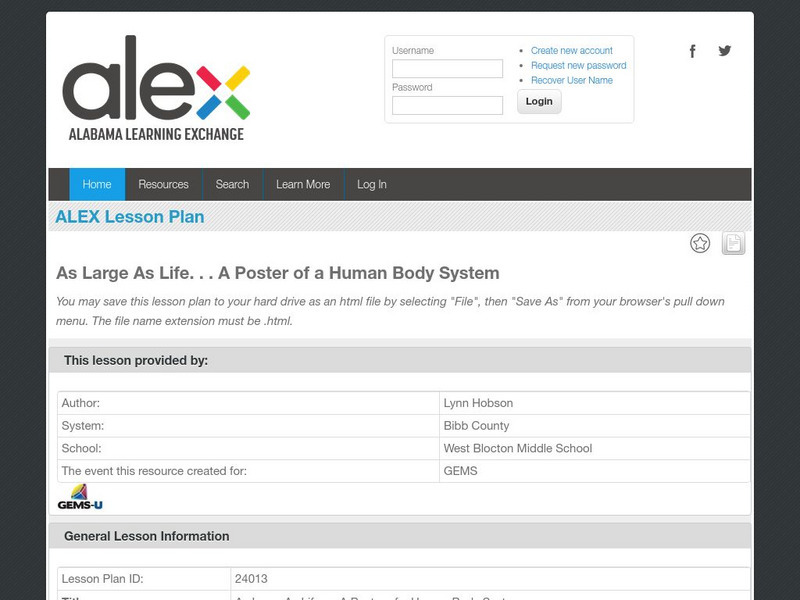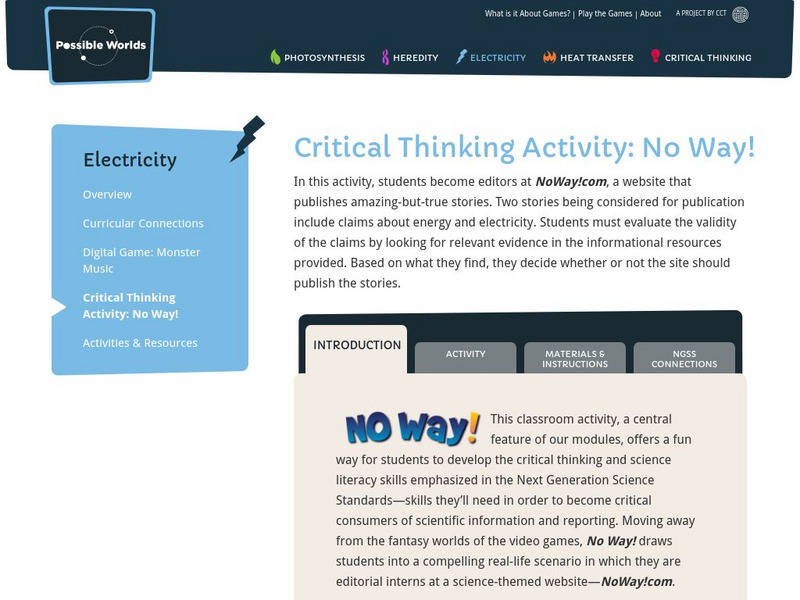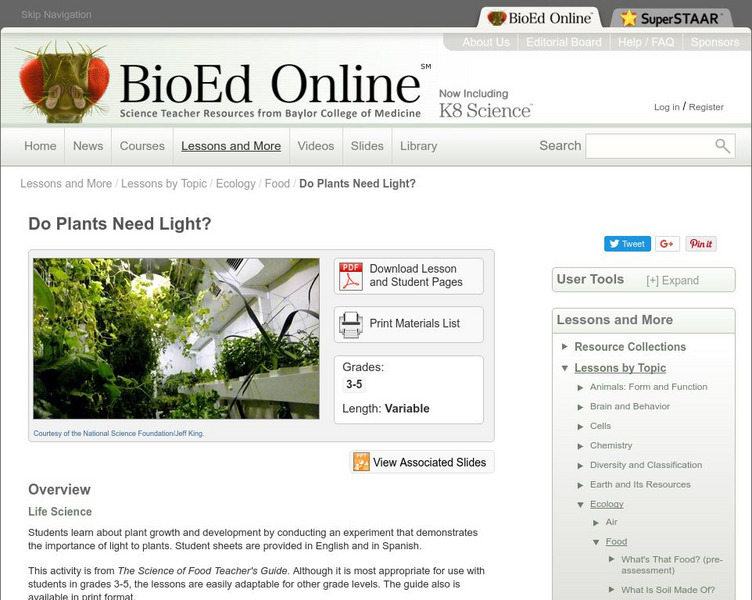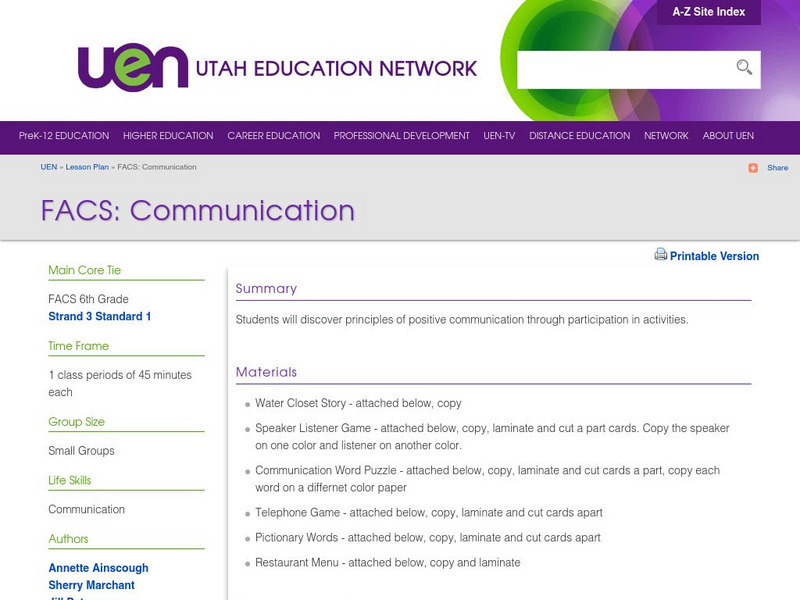Science Buddies
Science Buddies: Minding Your Mummies: The Science of Mummification
Mummies have always played a part in nightmares for Western cultures, but in ancient Egypt, mummification was a serious religious ritual. They believed that preserving human remains was necessary so that the previous owner could enjoy...
Alabama Learning Exchange
Alex: Diverse Life Forms of the Ocean
This lesson plan allows students to view and draw conclusions on the importance of life in the ocean. It uses student created movies to explore what is going on, as well as identifying the zones and diverse life associated with the...
American Geosciences Institute
American Geosciences Institute: Earth Science Week: Monitoring Life in the Rocky Intertidal Ecosystem
This activity will allow students to learn the sampling techniques used in the field by citizen scientists who participate in LiMPETS, five national marine sanctuaries along the West Coast.
Alabama Learning Exchange
Alex: Radiation / Half Life
The students will evaluate their personal radiation dose. They will develop an understanding of the term radiation and how it relates to everyday life. The will simulate how radioactive material decays and apply the term half-life....
American Geosciences Institute
American Geosciences Institute: Earth Science Week: Mystery Mollusc
Students become marine biologists, and their goal is to characterize the biological communities that live on or near the seamount in the Monterey Bay area. There, they must identify a mystery mollusk.
Alabama Learning Exchange
Alex: Science Writing With Author Lois Ehlert
This is an interdisciplinary language development unit addressing science and language arts standards designed for English Language Learners. In the week-long unit students will learn the life cycle of plants and discuss various uses for...
Alabama Learning Exchange
Alex: The Circles of Life
This is an inquiry based cooperative learning unit that can be used in biology as a graduation exam review or in botany for a nine week project. The students will learn the life cycle of mosses, ferns, gymnosperms and angiosperms. The...
Science Buddies
Science Buddies: Make a Miniature Habitat
Hands-on lesson plan in which learners use mostly natural materials to build a shoebox habitat that mimics a real-life habitat for an animal of their choice.
University of Kentucky
University of Kentucky: Earth Science Classroom Activities
A collection of links to activities and lessons that could be used for Earth science concepts including the foil record, creating a timeline of Earth's history, plate tectonics, dinosaurs, and the progression of life on Earth.
Other
My Science Box: Food Webs
In this lesson, learners will choose an organism of their choice and research its life cycle, food chain, diet, and habitat, then predict how habitat change might affect the organisms living within it.
PBS
Pbs Teachers: Scientific American: Science 911: Cop Psychiatrists
Investigate special conflict-resolution training for police officers and new high school programs designed to help resolve conflicts. Work in groups to develop possible solutions to real-life conflicts that have actually occurred at U.S....
Alabama Learning Exchange
Alex: Amazing Adaptations Probing Pinnipeds
This is a technology-rich, hands-on science experiment exploring the world of pinniped adaptations using a digital probe as a data collection device.
TeachEngineering
Teach Engineering: Life in Space: The International Space Station
Students are introduced to the International Space Station (ISS) with information about its structure, operation and key experiments. The ISS itself is an experiment in international cooperation to explore the potential for humans to...
Alabama Learning Exchange
Alex: As Large as Life a Poster of a Human Body System
This is a student led exploration of the systems of the human body through art and self-expression. Groups will cooperatively develop a poster, the size of a fifth-grade student, and will accurately depict the assigned system of the...
Education Development Center
Center for Children and Technology: No Way: Electricity
Moving away from the fantasy worlds of video games, No Way draws students into a compelling real-life scenario in which they are editorial interns at a science-themed website. This classroom activity on electricity offers a fun way for...
BioEd Online
Bio Ed Online: Do Plants Need Light?
Plants need air, water, soil, and light to grow. Students learn about plant growth and development by conducting an experiment that demonstrates the importance of light to plants.
Alabama Learning Exchange
Alex: Pretty Cool Penguins
This lesson plan is part of an interdisciplinary primary life science unit addressing adaptation and habitats by focusing on penguins. This lesson plan is primarily technology based and should take place near the end of the unit, after...
Writing Fix
Writing Fix: Patterns for Making Meaning
Students read the book The Way Life Works: The Science Lover's Illustrated Guide to How Life Grows, Develops, Reproduces, and Gets Along by Mahlon Hoagland to examine the sixteen patterns of life presented in the book. As students study...
Alabama Learning Exchange
Alex: The Very Busy Students: Writing With Eric Carle
In this interdisciplinary unit addressing science and language arts standards, English Language Learners will learn the life cycle of insects. They will also use the writing of a renowned children's author, Eric Carle, as a model for...
Utah Education Network
Uen: Facs: Communication
This activity will engage students in discovery learning. Through various tasks, 6th graders will learn the characteristics and challenges in daily family life that may be experienced when living independently. Communication skills are...
Alabama Learning Exchange
Alex: Seeds: How They Grow
The students will be collecting, germinating and planting seeds to show the process of plant growth. The students will be recording the information in their science journal. In addition, the students will be observing the water cycle as...
Alabama Learning Exchange
Alex: The Evidence of Chemistry
The students will learn to identify evidence that a chemical reaction has taken place. They will use the Internet to research evidence and find examples. They will look around their school and neighborhood for examples. They will perform...
PBS
Pbs Teachers: Methuselah Tree
Examine how scientists determine the age of living and non-living trees and identify factors that impact sizes of tree rings. Analyze tree ring samples and determine the age of the oldest sample.
Kinder Art
Kinder Art: Construct an Artquarium (Lesson Plan)
This lesson plan gives students a chance to create their own underwater animal out of paper-mache, and their imagination. Provides a colorful photo example, assessment criteria, and a suggested book to use for inspiration.
Other popular searches
- 4th Grade Life Science
- Life Science Inquiry
- Life Science Vertebrates
- Life Science Experiments
- K 2 Life Science
- Life Science on Cells
- Life Science Lesson Plans
- Grade 4 Life Science
- Life Science Report Topic
- Australia Life Science
- The Life Science
- Life Science Lessons
